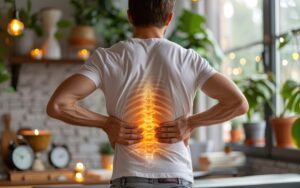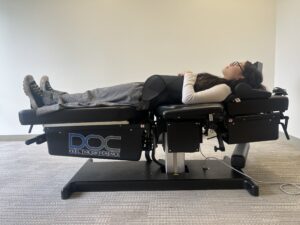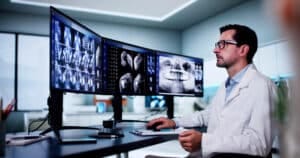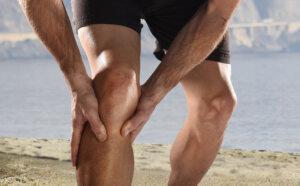Spinal stenosis causes wear and tear in the spine leading to the advanced stage of arthritis. Spinal stenosis is a result of a reduction in the space in the backbone.
What is spinal stenosis?
Spinal stenosis involves losing space inside the spinal canal. Just like you can have stenosis of the freeways when there are a lot of cars going through, you can have encroachment on the spinal canal. Now, it’s most common in the lumbar part of the spine, which is the lower back. Degenerative changes can take up space inside that canal. Less space means more pressure on the nerves and thus more irritation.
What does pain from spinal stenosis feel like?
Spinal stenosis pain is mostly felt in the back or in the legs. But spinal stenosis may not cause any pain at all. It can cause more intense symptoms such as progressive weakness in the lower extremities, again, meaning the legs. If it gets bad enough, it can also cause some bodily functions to lose control, such as the bladder and bowel movements.
What is the main cause of spinal stenosis?
The main cause of spinal stenosis is degenerative arthritis or instability in the spine. Some of the symptoms of spinal stenosis could be numbness in the legs due to pinched nerves, and loss of motor function as well into the lower extremities. The symptoms are mostly as you might take notice, caused by squeezing of the nerve root. Symptoms again most often occur in the lower extremities or the legs. Standing or walking can sometimes exacerbate or make your symptoms feel a lot worse.
How is spinal stenosis diagnosed?
Spinal stenosis is predominantly diagnosed with either an MRI or a CAT scan, and it’s reviewed by a radiologist and discussed with your primary care.
What part of the body does spinal stenosis affect?
It can definitely affect the neck, back, or low back. Meaning the mid back or low back. It can also cause difficulty with walking. Classic spinal stenosis can be presented with shorter distances of you being able to walk, along with much more.
How does Spinal Stenosis affect the body?
First and foremost, Spinal Stenosis can affect the neck, mid back, or the low back. Depending on what parts of the body it affects, you may get different types of symptoms. Some symptoms may be an effect of Spinal Stenosis of the lower part of the body, meaning the lumbar – could be difficulty with walking. Sometimes you may even be able to walk shorter distances, but you tire much quicker than you normally might. Spinal stenosis can also affect the neck and upper back. With those, you may get more arm & hand symptoms.
What types of people are prone to developing Spinal Stenosis?
Spinal stenosis generally affects the older population, so we’re looking at 60, 70 plus. As we age, there are more chances of degenerative arthritis, which can cause spurring and consequently, Spinal stenosis.
More reading we think you’ll like:
Can spinal stenosis be cured?
Spinal Stenosis is not curable. Good therapy and some activity modification can help to manage it. If the case shows severe symptoms, experts will immediately recommend surgery.
To get to the root cause of pain and discomfort, schedule an initial consultation, including a comprehensive evaluation and first treatment.
What are the best treatments to cure or manage Spinal stenosis?
If spinal stenosis gets severe enough, experts may recommend surgery to free up or decompress the nerves, causing less inflammation and less irritation. Professionals make use of the decompression fusion process to achieve this.
Surgery is indicated with advanced arthritis leading to pinching of the nerve or instability of the spine. Remedies that you can do to prevent getting to a point of surgery would be chiropractic treatments, acupuncture treatments, and physical therapy. That would be the best three-prong approach. The chiropractic is great, therefore really loosening up the joints, taking pressure off the nerves. Where acupuncture comes in is decreasing inflammation and irritation around the nerves and eventually, you’re going to want to strengthen those muscles and ligaments around the spine to help hold the structure. So physical therapy or rehabilitation is important mostly long term. So again, chiropractic, acupuncture, and physical therapy are definite musts with spinal stenosis.
Other things that could definitely be beneficial would be palliative care such as massage therapy, as well as flexion-distraction types of exercises that can help pump the lower back. And this pumping mechanism with these flexion distraction exercises can help get nutrients and water through an imbibition process to the discs to help really get all the nutrients to the disks as quickly as possible.
How can a person suffering from Spinal stenosis cope with the disease?
In addition to doing the recommended therapy, it’s important to keep active, keep moving and keep things fluid. Going on daily walks can help. Experts recommend more flat walking, so avoid hilly areas and high elevations.
Another thing that could be very beneficial would be swimming. Swimming kind of helps take the weight off the body and takes your joints through a full range of motion, loosening up the area, and de-inflaming the area.
Making sure that you have good sleep ergonomics, as well as sitting and standing ergonomics. So it’s important to get an Ergonomic professional to possibly take a look at your setup to make sure that you’re doing everything you can possibly not to irritate the area any further. One thing to note is that when Spinal stenosis gets bad enough, it can cause radiating symptoms. So symptoms down the legs as well as bowel and bladder dysfunction. If we get to this point, it’s really important to get to the emergency room as quickly as possible. This could indicate a surgical intervention and that’s probably what our experts at Truspine would recommend at that point in time.
Are you having shooting pains down the back of your legs? This could be spinal stenosis. At our San Francisco clinic, we have spinal stenosis experts that are ready to take action, evaluate and give you the right and best care plan. It’s important to get a very thorough examination. Give us a (415) 421-1115.
You can schedule an appointment with our San Francisco chiropractor to get correctly diagnosed or have a free 15-minute phone consultation.



